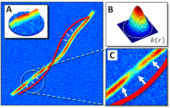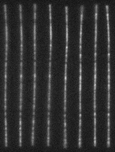Highlight
New Spectral Analysis Algorithms Enable Robust Measurement of Flexural Rigidity of Biopolymers
Achievement/Results
David Valdman, a Mathematics PhD student and IGERT trainee, together with his advisor Prof. Paul Atzberger, have collaborated with Prof. Megan Valentine of Mechanical Engineering to develop a MATLAB image processing toolbox specifically designed to analyze experimental data gathered in the Valentine lab.
The Valentine lab focuses on understanding mechanical properties of microtubules (MTs), a biopolymer found in all eukaryotic cells, which is essential to cell organization, motility and division. The lab investigates how certain proteins interact with MTs and affect mechanical properties such as stiffness. Because of their role in cell division, understanding the physical properties of MTs and their relationships to certain binding proteins may lead to new cancer treatments.
There are several ways to investigate these biopolymers in vitro. One of the more common is fluorescence microscopy, where MTs are fluorescently dyed and imaged with an optical microscope. By taking snapshots of the microtubules and observing their thermal fluctuations in time, key mechanical properties can be deduced. Using more sophisticated methods, heterogeneities in structure that are important physically but are still poorly understood theoretically can be probed.
It is at this bridge where the collaboration has been most fruitful. Valdman and Atzberger have developed an image processing toolbox that draws from mathematical techniques from functional analysis, spectral methods, statistics, thermodynamics and numerical computing, and is designed to address the inherent challenges arising from these laboratory experiments. Fluorescence microscopy, in this setting, is difficult because of inherent image noise, coupled with the rigidity of MTs. To the naked eye, MTs look nearly exactly straight; resolving the small deviations from linearity is essential. This prompts the need for the more robust methods that were developed. The accuracy of the new methods has been theoretically validated. The algorithms were applied to data from the Valentine lab to obtain results that were more accurate, and with known error bounds. Prior to this work, such sharp results were absent from the literature.
As a result of this work, the experimental agenda in the Valentine lab has changed; the lab is generating microtubules with certain heterogeneities that the new algorithm can detect. These heterogeneities should lead to physical structure that deviates from standard theory in a way that we will be able to quantify, thus coming closer to understanding how certain proteins can affect MT structure.
Address Goals
Discovery: New mathematical algorithms were developed to address an important limitation in experimental methods.
Research Infrastructure: A MATLAB-based toolbox was developed.









